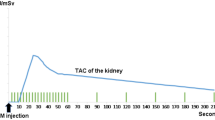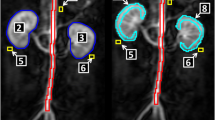Abstract
Quantitation of the 99mTc-diethylenetriaminepentaacetic Acid (DTPA) scan yields by uptake analysis an estimate of individual kidney glomerular filtration rate (IKGFR) and by deconvolutional analysis an estimate of the mean transit time (MTT) of the non-reabsorbable tracer through the kidney. The whole kidney MTT is compounded of the renal parenchymal MTT and the rate of pelvic clearance; both functions are influenced by prevailing rates of salt and water excretion. The present study was undertaken to investigate the effect of physiological variations on the normal DTPA scan. The contralateral normal kidney in 11 children with suspected unilateral urinary tract obstruction were studied twice, first with an early morning scan (EMS) and second, 24 h later, following hypotonic volume expansion (HVE).
A strong correlation was shown between urine osmolality and MTT.
IKGFR was independent of the state of hydration, but in comparison to mild hydration, HVE shortened significantly (P0.001) the normal whole kidney MTT, with less effect on parenchymal MTT (P0.01) and therefore has its predominant effect on pelvic clearance.
We advise caution in the interpretation of whole kidney transit time analysis without standardization of salt and water excretion rates. Parenchymal transit time offers a potentially useful clinical index.
Similar content being viewed by others
References
Britton KE, Brown NSG (1971) Clinical renography. Lloyd-Luke, London
Diffey BL, Hall FM, Corfield JR (1976) The 99m TC-DTPA dynamic renal scan with deconvolution analysis. J Nucl Med 17:352–355
Fermelant MH, Bakos K, Burrows BA (1969) Physiological determinants of renal tubular passage times. J Nucl Med 10:641–645
O'Reilly PH, Testa HJ, Lawson RS, Farrar DJ, Edwards EC (1978) Diuresis renography in equivocal urinary tract obstruction. Br J Urol 50:76–80
Piepsz A, Dobbeleir A, Erbsmann F (1977) Measurement of separate kidney clearance by means of 99m Tc-DTPA complex and a scintillation camera. Eur J Nucl Med 2:173–177
Piepsz A, Ham HR, Erbsmann F, Hall M (1982) A co-operative study on the clinical value of dynamic renal scanning with deconvolution analysis. Br J Radiol 55:419–433
Soriano JR, Vallo A, Castillo G, Oliveros R (1981) Renal handling of water and sodium in infancy and childhood: A study using clearance methods during hypotonic saline diuresis. J Pediatr Nephrol Urol 1:5–10
Vivian G, Gordon I (1983) Comparison between individual kidney GFR estimation at 20 minutes with 99m Tc DTPA and 51 Cr EDTA GFR in children with a single kidney. Nucl Med Commun 4:108–117
Zieler KL (1965) Equations for measuring blood flow by external monitoring of isotopes. Circ Res 16:309–313
Author information
Authors and Affiliations
Rights and permissions
About this article
Cite this article
Vivian, G., Barratt, T.M., Todd-Pokropek, A. et al. Physiological variations of normal transit time in children. Eur J Nucl Med 11, 179–181 (1985). https://doi.org/10.1007/BF00251370
Received:
Issue Date:
DOI: https://doi.org/10.1007/BF00251370




